
The Pandya dynasty, also known as the Pandyas of Madurai, was a dynasty of south India, one of the three ethnically Tamil lineages, the other two being the Chola and the Chera. The rulers of the three dynasties were referred to as "the three crowned rulers of the Tamil country". The Pandyas ruled extensive territories, at times including the large portions of present-day south India and Sri Lanka.
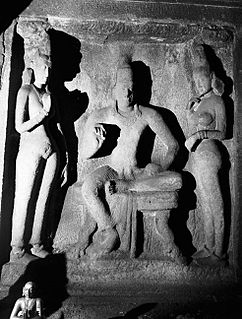
Simhavishnu, also known as Avanisimha, son of Simhavarman III and one of the Pallava kings of India, was responsible for the revival of the Pallavan dynasty. He was the first Pallava monarch whose domain extended beyond Kanchipuram (Kanchi) in the South. He was portrayed as a great conqueror in Mattavilasa Prahasana, a drama written by his son Mahendravarman I.

Aditya I, the son of Vijayalaya, was the Chola king who extended the Chola dominions by the conquest of the Pallavas and occupied the Western Ganga Kingdom.

Vijayalaya Chola was a king of South India who founded the imperial Chola Empire. He ruled over the region to the north of the river Kaveri.

The region of Tamil Nadu or Tamilakam, in the southeast of modern India, shows evidence of having had continuous human habitation from 15,000 BCE to 10,000 BCE. Throughout its history, spanning the early Upper Paleolithic age to modern times, this region has coexisted with various external cultures.

Tamil architecture or the South Indian temple style is an architectural idiom in Hindu temple architecture that emerged in the southern part of the Indian subcontinent or South India and in Sri Lanka, reaching its final form by the sixteenth century. It consists primarily of Hindu temples where the dominating feature is the high gopura or gatehouse; large temples have several. Mentioned as one of three styles of temple building in the ancient book Vastu shastra, the majority of the existing structures are located in the Southern Indian states of Andhra Pradesh, Karnataka, Kerala, Tamil Nadu and Telangana. Various kingdoms and empires such as the Cholas, the Chera, the Kakatiyas, the Pandyas, the Pallavas, the Gangas, the Kadambas, the Rashtrakutas, the Chalukyas, the Hoysalas, and Vijayanagara Empire among others have made substantial contribution to the evolution of Tamil architecture.

Narthamalai(Tamil:நார்த்தாமலை), a cluster of small hills, is 25 km from Trichy on the Trichy-Pudukottai highway in the state of Tamil Nadu, India. Here can be seen some of the oldest rock cut cave temples, as well as the longest rock-cut edicts, similar to Asokan edicts and extremely rare in the south of India. The town houses Vijayalaya Choleeswaram built during the 9th century. The two rock-cut temples are classic examples of how temple architecture styles were fusing in different parts of the country.
Maravarman Rajasimha I, also known as Pallavabhanjana, was a Pandya king of early medieval south India. He was the son and successor of Ko Chadaiyan Ranadhira. He remembered for his important successes against the Pallavas and in the Kongu country.
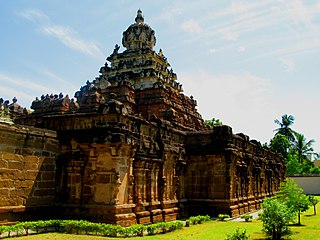
Thiru Parameswara Vinnagaram or Vaikunta Perumal Temple is a temple dedicated to Vishnu, located in Kanchipuram in the South Indian state of Tamil Nadu. Constructed in the Dravidian style of architecture, the temple is glorified in the Divya Prabandha, the early medieval Tamil canon of the Azhwar saints from the 6th–9th centuries AD. It is one among the 108 Divyadesam dedicated to Vishnu, who is worshipped as Vaikuntanathan and his consort Lakshmi as Sri Vaikundavalli. The temple is considered the second oldest extant temples in Kanchipuram after the Kailasanthar temple.
Muthuraja or Mutharaiyar also known as Kudiyaanavar, Ambalakarar is a Tamil speaking community prevalent in southern India. They were historically zamindars and landlords. Their primary occupation is agriculture and trade. The Muthuraja people are the descendants of the Muttaraiyar line of kings who ruled the districts of Trichy, Thanjavur and Pudukottai between the sixth and the ninth century. The Muthuraja people are spread throughout rural area around Trichy region. The community is mostly distributed in the Tiruchirappalli, Pudukkottai, Tanjore, Karur and Perambalur districts of Tamil Nadu.
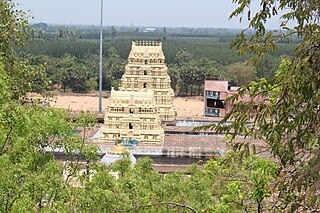
Devanathaswamy temple in Thiruvanthipuram, a village in the outskirts of Cuddalore in the South Indian state of Tamil Nadu, is dedicated to the Hindu god Vishnu. Constructed in the Dravidian style of architecture, the temple is glorified in the Divya Prabandha, the early medieval Tamil canon of the Azhwar saints from the 6th–9th centuries AD. It is one of the 108 Divyadesam dedicated to Vishnu, who is worshipped as Devanathaswamy and his consort Lakshmi as Hemabhujavalli. Though the presiding deity is Devanathaswamy, the temple is known for Hayagriva, the horse faced avatar of Vishnu. The temple is the only historical temple in South India to have a shrine of Hayagriva.

Neyyadiappar Temple, Tillaistanam is a Hindu temple dedicated to Shiva located in the village of Thillaistanam also known as Tillaistanam or Thiruneithanam in Tamil Nadu, India. It is significant to the Hindu sect of Saivism as one of the Sapthastanam, the seven temples associated with Aiyarappar temple in Thiruvaiyaru. Shiva is represented by the lingam in the form of Neyyadiappar. His consort Parvati is depicted as Piraisoodi Amman. The presiding deity is revered in the 7th century Tamil Saiva canonical work, the Tevaram, written by Tamil saint poets known as the nayanars and classified as Paadal Petra Sthalam.
Hinduism in Tamil Nadu finds its earliest literary mention in the Sangam literature dated to the 5th century BCE. The total number of Tamil Hindus as per 2011 Indian census is 63,188,168 which forms 87.58% of the total popualation of Tamil Nadu. Hinduism is the largest religion in Tamil Nadu.

Nearly 33,000 ancient temples, many at least 800 to 2000 years old, are found scattered all over Tamil Nadu. As per Tamil Nadu Hindu Endowments Board, there are 38615 Temples. Most of the largest Hindu Temples reside here. Studded with complex architecture, variety of sculptures, and rich inscriptions, the temples remain the very essence of the culture and heritage of Tamil land, with historical records dating back to at least 3,000 years.

The Vaikunta Perumal Temple in Uthiramerur, a village in the South Indian state of Tamil Nadu, is dedicated to the Hindu god Vishnu. The temple is constructed in the Dravidian style of architecture. Vishnu is worshipped as Vaikunta Perumal and his consort Lakshmi as Anandavalli. The temple was originally built by Pallavan, with later additions from the Chola. The temple is known for the inscriptions indicating the democratic practises of electing representatives for the village bodies during the regime of Parantaka Chola.
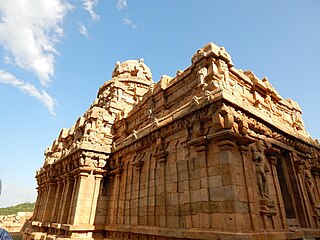
Vijayalaya Choleeswaram in Narthamalai, a panchayat town in Pudukottai district in the South Indian state of Tamil Nadu, is a temple dedicated to the Hindu god Shiva. Constructed in the Dravida style and rock cut architecture, the temple is believed to have been built during the 9th century by Muttaraiyar kings, the cardinals of Pallavas, with later expansion from the Cholas. The rock-cut architecture is an early example of Cholan Art, continuing the tradition of the Pallavas. The other portions of Narthamalai houses the 8th century Jaina Abode, the Aluruttimalai Jain Caves. There are also two rock-cut caves, one of which houses twelve life size sculptures of Vishnu. The temple is considered one of the oldest stone temples in South India.

Avanibhajana Pallaveshwaram temple also called Stambeswarar Temple is a Hindu temple dedicated to Shiva, located in the town of Seeyamangalam, Tiruvannamalai district in Tamil Nadu, India. The temple is constructed in Rock-cut architecture by the Pallava king Mahendravarman I during the 7th century. The cave temple had later additions from the Chola and Vijayanagar Empire.

Kunnakudi Shanmughanathar temple in Kundrakudi, a village in the outskirts of Karaikudi in Sivaganga district in the South Indian state of Tamil Nadu, is dedicated to the Hindu god Murugan. Constructed in the Dravidian style of architecture, the temple is located in the Tirupattur - Karaikudi Road, around 14 km (14,000 m) from Karaikudi. There are three caves located on the western side of the lower rock, that has rock-cut shrines from the Pandyan Empire from the 8th century. The caves have the earliest sculptural representation of Dvarapalas, the guardian deities, for any South Indian temple.

Trilokyanatha Temple in Thiruparthikundram, a suburb in Kanchipuram in the South Indian state of Tamil Nadu, are dedicated to the Jain religious figures. It is associated with Digambara sect of Jainism. Constructed in Dravidian architecture, the temple is believed to have been built during the reign of Pallava dynasty during the 8th century with later contribution from Medieval Cholas, later Pallavas and Vijayanagar kings.
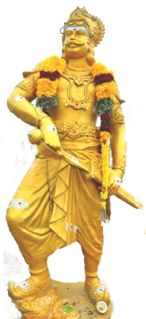
The Mutharaiyar dynasty was a royal family in what is now the Indian state of Tamil Nadu. They governed the Tanjore, Trichy and Pudukottai regions between 600-900 CE.





















